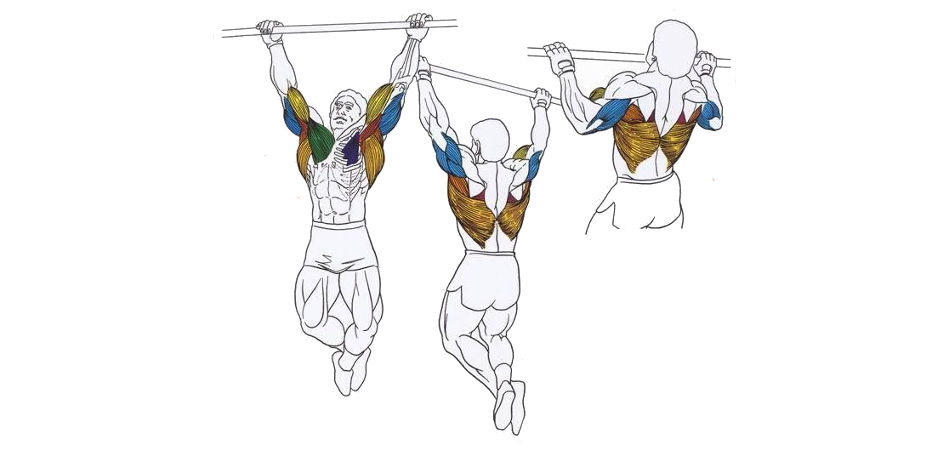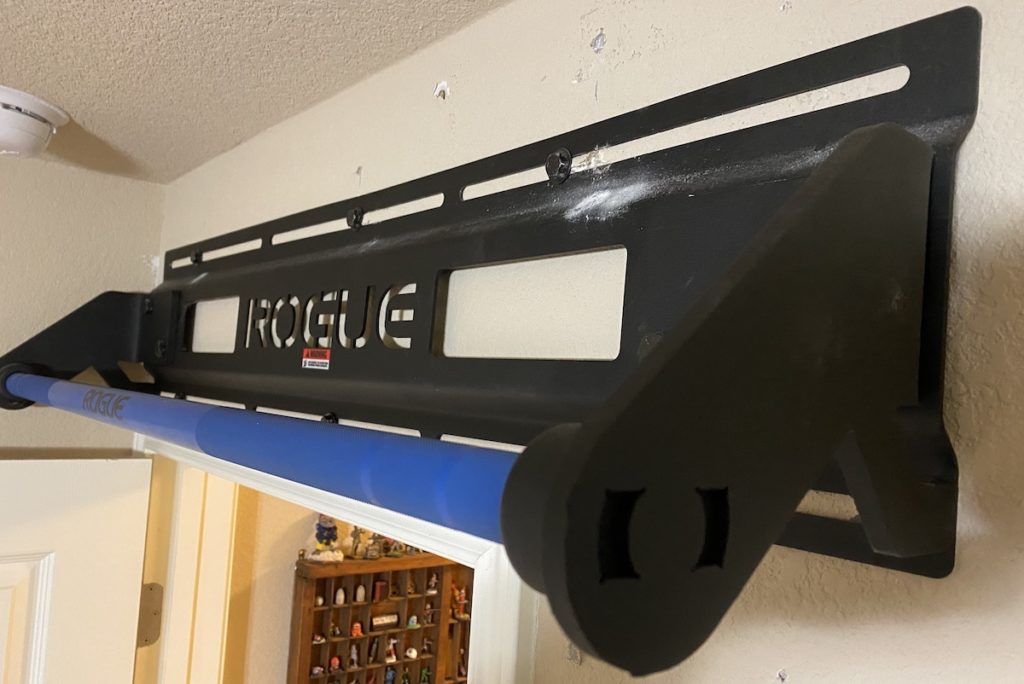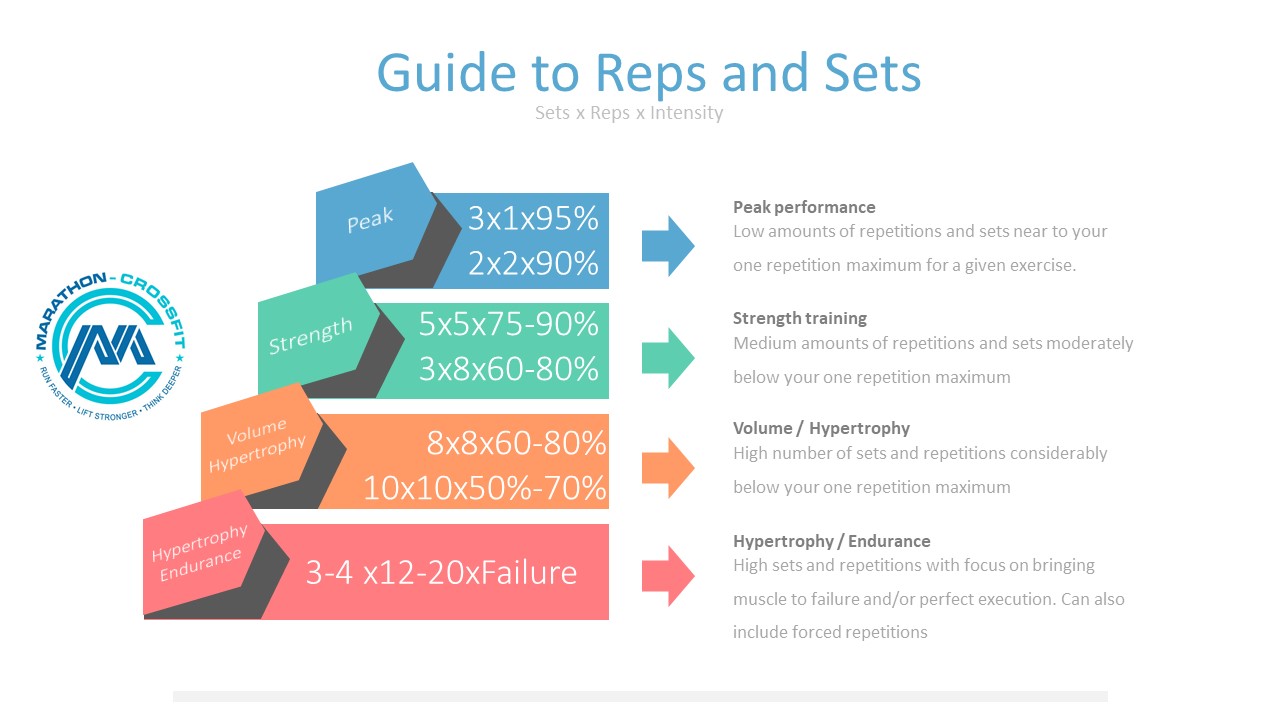Will Pull ups build mass?
Pull-ups are not the best way to put on mass, as they usually do not lend themselves to high repetition schemes. They are a very useful tool for building lean muscle mass for intermediates and advanced athletes. Beginners are better off starting with variations to progress towards a strict pull-up.
Related articles
What is a pull-up?

A pull-up is performed hanging from a bar while only holding on with your hands. The palm of your hands face away from you while you hold on to the bar. The movement starts from a full hang and ends when you brought your chin over the bar. Ideally, you avoid creating momentum by swinging your legs and kicking. Still, there are some variations like the kipping pull up that allow for that. Pull up's train the following muscles:
-
Latissimus dorsi: largest upper back muscle that runs from the mid-back to under the armpit and shoulder blade
With this, it is also considered the squat for the upper body by some strength coaches.

Equipment for pull-ups
This is a list of equipment required for doing pull-ups. I recommend investing in good quality, reliable equipment so you have fun using it. There is nothing worse than faulty equipment that hinders your progress.
When you do some research you will find many variations of door frame pull up bars. The major variations are the ones that are anchored in the wall, held by the frame by your own bodyweight, and the ones that can be expanded until they sit tightly in the door. The least likely to damage your door frame are the ones that will be anchored into the wall. Pull up bars that hold because of your own bodyweight or by letting them expand to fit the frame are accidents waiting to happen. My personal favorite is the Rogue Jammer pull up bar. It is stable, has been designed by one of the top producers in the market, and the result of many iterations of pull up bars.
If you are intending to do muscle-ups or kipping pull-ups you will need some clearance from the wall. The jammer bar will not fit the bill. You will need a pull-up bar with a steel frame for stability. The Rogue P-4 pull up bar fits the bill for this purpose.
Weighted vests and dip belts can be used to make the pull up more challenging. If you are considering one of the two I would recommend a vest over a dip belt. A vest will provide more freedom of movement at the cost of taking less load. If you want to have as much weight as possible on you to do pull-ups then get a dip belt.
Bands of various resistance can be used to make the pull up easier. The sturdier the band the easier becomes the assisted pull up. You loop the band to the bar and step in with one or both of your feet to help yourself up.
If you want to manipulate the angle of the pull up to make it easier a rack and a barbell are an easy option. Don’t get these just for doing pull ups as that would be too expensive. I personally use a Rogue Ohio power barbell and a Rogue RM4 rack in my own home gym.
Can pull-ups build Mass
Yes, they can compared to doing no exercise. Eating ten bags of chips every evening will also build mass. The question „can pull-ups build Mass“ is therefore incomplete.
What you are probably asking is “Can pull-ups build muscle mass”. Pull-ups are not necessarily the best choice to build muscle mass for a couple of reasons:
-
Most people can not do pull-ups for high reps
-
The heavier you get the harder pull-ups become
-
Focusing too much on which exercises you are doing rather than how you are executing them is a common mistake for building mass
-
Pull-ups leave out abs, glutes, and legs
The first thing is that many people can not do pull-ups for high repetitions. Hypertrophy programs usually work with 8-20 repetitions per set. If you are able to do multiple sets of pull-ups for twenty repetitions you are either very scrawny or as fit as a fiddle. This means the average Joe will not be able to follow a training protocol optimized for building muscle mass using pull-ups. You can use variations of the pull up with machines or bands to make it easier, but still, there are easier ways to start a program to build mass then getting a pull-up bar and awkwardly attaching a band to it to make the exercise easier. If you want to do pull-ups to increase your fitness, you can use Progression exercises like negatives, band-assisted pull-ups, and kipping pull-ups. If you want to be the biggest guy in the room, you can avoid these especially when you start.
Another reason that pull-ups are not ideal for building mass is sheer physics. The heavier you are the harder pull-ups become. The biggest strongmen have lots of mass and are strong like bulls. Yet many of them do not come near 20 pull-ups in one set. The ones who hold the world records in this arena are usually low in mass and body fat to make optimal use of the physics. This is completely contrary to exercises like the bench press, squat, and deadlift which become easier the bigger you get. Therefore the more mass you build, the less likely it will become you will use pull-ups as a regular part of your training.
The last point against using pull-ups for mass is that your focus might be misaligned. Especially beginners often focus too much on which exercises they are doing and how much weight is on the bar rather than on how the exercise is executed. You can get a great pump out of lifting a pencil if you mainly focus on tension and move very slowly. Muscle mind connection and high repetitions per set are often more likely to make you big than small numbers of repetitions and high weight. Pull-ups range in the ladder category.
The last thing is that the pull up will leave the lower parts of your body untrained. Especially if pull-ups are the main or only type of training you will be doing. This is a little unfair as there is a lot to be said for isolation exercises for building mass compared to compound movements. Still, if you are only going to do one exercise for the rest of your life to build mass, you shouldn’t t make it the pull up as you will end up with chicken legs.

Components for building mass
When you start out to get bigger and stronger the focus is often on hitting the gym as often and hard as possible. While this certainly plays a role there is a tendency in beginners to overemphasize complexity and intensity in exercise selection. Other very important components for building mass are overlooked. These are:
-
Food
-
Sleep
-
Hormones
-
Execution
-
Balance
Food splinters into a wide field. To keep it simple you look at your calorie intake, macronutrients and the quality of the food that you eat.
The biggest athletes are bodybuilders and strongman competitors. You will usually find that they eat more than four times a day. Their calorie intake usually exceeds 4.000 calories a day and can go up to 10.000 calories a day. Their diets mainly consist of protein and fat. Carbohydrates are usually minimized. They try to keep these calories as clean as possible with very little processed foods and supplements. Still, if you have to exceed 4.000 calories a day you will welcome a protein shake here and there. Just try for three to five days to hit that goal and you will see how hard it can become without supplements.
Sleep is another big component of building mass. Some of the greatest strongmen in the business like Brian Shaw, Hafthor Bjornsson, and Eddie Hall claim that they go to bed early, sleep long into the day, and have a nap after training in the morning and/or in the afternoons. Ed Coan, considered by many to be the greatest powerlifter of all times, followed the same routine of a nap a day. If you are only sleeping five to six hours a day you are actively hindering your progress. You do not need to go as extreme as the top athletes, but being in bed before 10 pm each day is a good start.
Hormones are another big component of building mass. Testosterone and growth hormones peak when you are a baby and during puberty. After puberty, you are starting to fight an uphill battle, as your hormones for growth will become less common in your body. Strength training can counteract this to a certain degree, but not reverse the process. Hormones are one of the major areas of doping to keep growth rates high. If you do not want to inject there are less potent ways to manage your blood and hormones via your diet and lifestyle. Remember that tinkering with hormones and taking low-quality products can have massive negative effects on your body. Consult a doctor to weigh up the pros and cons to evaluate the risk. If you do decide to take medication, make sure you source it from a reliable trusted source and know what you are putting into your body.
Another area for growth is how you execute each repetition. You can get great effects with low weights if you move them slowly and controlled through the full range of motion. Especially if building mass is your main goal it does not matter how much weight is on the bar, but how strongly your set stimulates you to grow.
The last point which is often overlooked is balance. Your exercise regimen should be balanced between all parts of the body to avoid long term injuries. The more one-sided and intense your training is the more likely it becomes that you will suffer from an injury that will keep you out of the gym for a longer time. Embrace intensity is it is needed to stimulate growth in your body. Be smart about where you push to the limit and beyond. Pushing for 3 more reps on a set of 15 is smart for growth. Pushing for two more reps on a very heavy squat set of three that already feels like a flaming pile of crap is stupid.

Sets and reps for mass
There is an ever-repeating discussion about whether high repetitions with low intensity or low repetitions with high intensity are the better approach to get stronger and bigger. The full answer is both.
If you look at the most successful strongmen and bodybuilders they will tell you that they experimented a lot. Grip variations, variations on the range of motion, high repetitions, and low repetitions are all part of the very successful strength athlete's repertoire. These are not mutually exclusive and the best of the best use all of the tools available to them. So do not follow dogma and keep trying things to learn and stay interested.
That being said there is a general bias towards high repetitions and lower intensity for the goal of building mass. Many programs work with 3 x 12 to 15 or 15 to 20 repetitions. This is where the blood gets pumping. You can also look into widowmaker sets and AMRAP sets.
3-5 repetitions per set are a range for strength gains. That is usually the area beginners start. Advanced athletes will add weight to the movement by using a vest or kettlebells. A dip belt can also be used.
There is also evidence that supports that the amount of sets and repetitions does not make a real difference for performance, as long as you get a certain amount of volume in. The challenge with studies in strength training is that they biased towards men of university age are often poorly designed and short-termed. The body of studies would be improved by more research on female and elderly subjects where variables like diet are highly controlled.
Which type of pull-ups to do for mass
To build mass with pull-ups you can look at different types of pull-ups. There are thousands of variations out there and I recommend trying a lot of them while keeping your fitness level in mind. Executing something perfectly before moving on to a harder variation pays dividends in the long run. Here are the components of the pull up you can vary:
-
Grip
-
Range of motion
-
Angle
-
Medium
-
Execution
The most obvious variations of the pull up are grip alterations. You can grip narrow, wide, with the palm of the hand facing towards you or away, one-handed, with the thumb around the bar or not, all fingers, two fingers and so further. The list is endless and if you really want to get the maximum out of the pull up become an avid student of calisthenics.
The wider the grip the harder the pull-up usually becomes. The narrower the grip the easier the pull-up usually becomes. Pull-ups with a wider grip focus more on your lats and back with bad leverage. Pull-ups with a narrow grip focus more on your biceps and triceps with better leverage. Grip strength also plays a role in pull-up strength and I encourage you to use captains of crush grippers today also work on that end of your strength.
A full range of motion is recommended for building mass. This means that you go to the lowest position of the pull up in full hang and back up from there. More advanced concepts are forced repetitions with a partial range of motion and negatives. Forced reps are used at the end of a set to get the maximum out of the muscle and get a burn. You might also call them garbage reps. I find them most effective on sets of 12-20. So this is a concept not that well suited for beginners on pull-ups. Negatives start at the top of a pull-up and you then slowly lower yourself to the ground. This usually requires a box to get into the starting position. Negatives are a very effective tool for beginners to progress to their first pull up.
Another variable of the pull up is the angle at which you do them. The classic pull up is done at 90 degrees to the ground. This is the hardest variation as gravity works the most against you. A good way for beginners to progress to their first pull up and get more volume in is to alter the angle. One of the easiest ways to manipulate the angle is to use a barbell and adjust its height. Just pull yourself up to the bar and go higher and higher once you become stronger.
Another variable is the medium you hold onto. You can do pull-ups from a pull-up bar, barbell, sphere, ledge, and various other grips. These variations usually make the pull up harder and trading your grip more than just holding on to a pull-up bar. Especially climbers and wrestlers will get the benefits of using different media to hold onto once they are proficient in doing multiple pull-ups per set.
Execution of the pull up is another bone of contempt in online discussions. One side of the argument favors kipping pull-ups as you get more repetitions in per set and therefore a higher stimulus for growth. The other camp favors strict pull-ups as they are safer and more controlled. Strict pull-ups have a longer time under tension which also helps with building muscle. I personally lean more towards the strict pull up for building mass as it is also a prerequisite for doing kipping pull-ups. In most home gym setups the kipping pull-up won’t even be an option as the pull-up bar is too close to the wall.
The best way for beginners to use pull-ups for mass is to alter the angle and make them easier. The goal is to get in a range of more than ten repetitions per set with full control. Advanced athletes can use variations of the basic pull up based on their goals. Bodybuilders might want to do more chin-ups for a wider and thicker back, while martial artists will use kipping pull-ups and grip variations for explosiveness and a grip of steel.
Basics of muscle growth
Training for muscle growth usually seeks out to train your skeletal muscle. Your body has three different types of muscle. These are cardiac muscles, smooth muscles, and skeletal muscles. Training smooth and cardiac muscles directly is hard and next to impossible. Regular cardiovascular exercise does make it more likely that your heart muscle and other cardiovascular systems grow and become more sturdy. In the context of whether pull-ups can build mass, you are looking at skeletal muscle. Skeletal muscles help you to move. They are also the muscles you see on stage in any bodybuilding show.
Muscle growth occurs when your rate of protein synthesis is greater than the rate of muscle protein breakdown. Regular exercise can increase protein synthesis. Your diet can support, that enough components are available for protein synthesis to happen. Building proteins in muscles occurs when you rest, not when you train. This process has many variables like cell structure, testosterone, and insulin levels in your body, and the activation of satellite cells. While this can get very complicated in detail it means in simple terms that you have to keep the levels of testosterone high, challenge your body to build protein, and eat enough. You will often find these three classifications of people depending on your various capabilities to gain muscle
-
Mesomorphic: People with this body type tend to be muscular and generally build muscle mass far more quickly than people with other body types.
-
Ectomorphic: This term describes a slim or straight frame. Ectomorphs have a lower chance of building muscle mass but can increase their strength through resistance training.
-
Endomorphic: This body type is more rounded or curvy. People with an endomorphic body can build muscle most effectively through strength training.
To build muscle you have to give your body a reason to have more muscle. Exercise is a good way to do this. The other factor you can influence is your diet. Apart from that, you can get as complex as you possibly want, but if your main goal is muscle mass it is good to get started with the basics of a good diet and hard work and then learn about the details along the way.
Example workouts
Some example workouts for getting better at pull-ups are:
Hangs
Pyramids
100 for time
Hangs are good if you can not do a pull up yet. Explore other forms of exercises for reps to grow stronger and incorporate hangs for time to check whether you are getting stronger. Once you can hang from the bar for more than 60 seconds you can start to towards your first pull up.
Pyramids are a great way to work on getting more volume in for intermediates. You do 1 rep, then take a breath. After this, you do 2 repetitions and take two breaths. You continue this process until you can not add another rep to a set. This technique helps you to get more work in while also having an easy check mechanism whether you are improving. Once you reached the maximum amount of repetition per set you work your way back down in the same way. When you write the reps per set down it will be 1,2,3,4,5,4,3,2,1 which looks like a pyramid.
Once you are very advanced you can start to do 100 pull-ups for time. This is where kipping pull-ups can come in handy as you can do them much faster than strict pull-ups.
Conclusion
Pull-ups are a great exercise to define your body, get stronger, and build muscle. They have limitations when your main interest is to get as big as you possibly can as your own body weight acts as an obstacle to pile on more repetitions. If it is lean muscle mass you are after, then there are only a few exercises that are as effective and efficient for your upper body as the pull-up.
